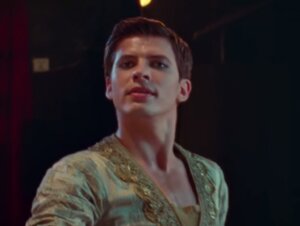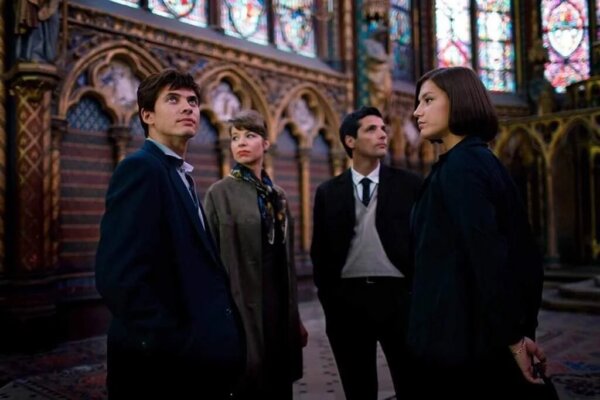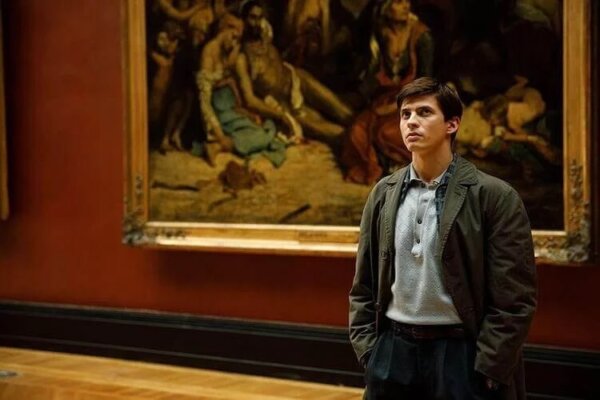The White Crow: The Story of Rudolf Nureyev

Ralph Fiennes is a renowned actor who’s acted in many famous films. His family is also well-known in the field of film. His sister is the director, Martha Fiennes, and his brother is the actor Joseph Fiennes. In 2011, Ralph Fiennes decided to take the leap to become a director with the film Coriolanus and later The White Crow in 2018.
The White Crow tells the story of Russian dancer Rudolf Nureyev. It’s an intimate portrait of the dancer that follows him through his difficult childhood up to the decision that changed his life forever. That was his decision to seek political asylum in France.
Fiennes stated that he became interested in Nureyev when he read the book Nureyev: The Life by Julie Kavanagh. Fiennes said that, when he originally read the book, he had no intention of making a film but that the idea took shape over time.
Kavanagh’s book reflects the two sides of the dancer very well. On the one hand, Nureyev’s undeniable talent as a dancer. On the other hand, his difficult character.
The making of The White Crow
Fiennes researched the ballet world in depth. In fact, he chose an experienced ballet dancer, Oleg Ivenko, to play Nureyev. That’s because Fiennes didn’t want to employ an actor who would have to take dance classes and in the most complex situations would require a double. Indeed, he wanted to capture the very essence of Nureyev and felt a dancer would better emulate his movements.
Without a doubt, this fact makes the film an aesthetic delight that enthralls ballet lovers. However, it also captivates viewers less familiar with ballet. Furthermore, despite the film’s undeniable political edge, it’s actually a story of art. Undoubtedly, it’s about the art of dancing but it also tells you how your past and the decisions you take make you who you are and forge your destiny.
A difficult past
The structure of the film isn’t linear. There are episodes of Nureyev’s past in the form of flashbacks. He was born on a train and grew up in a rural area near Uufá. In fact, he had a difficult childhood marked by poverty and misery. Although he showed great dance skills, he came quite late to dance training, due to the shortcomings of his childhood. In 1955, he was sent to Leningrad, where he attended ballet school. There, he came into contact with Alexander Pushkin (portrayed by Fiennes) who became his teacher.
Nureyev’s past seems to have deeply affected him. Little by little, the film shows him as an arrogant and self-centered person. Furthermore, he appears to be in a state of continual hypervigilance, as if he believes that everyone’s conspiring behind his back.
In several interviews, Fiennes explained that he wanted to show the viewer why Nureyev made certain decisions and how his past shaped him into an unpleasant person. In fact, he may have danced like a god, but he was extremely difficult to deal with. At least, that’s what Julie Kavanagh suggested in her book, and this sentiment is equally present in the film.
Being born on a train, living in misery, and not having had a decent education clearly scarred Nureyev for life. It’s evident that he was a unique character, irreverent and undisciplined, with an unmatched talent for dancing.
Background and story of The White Crow
The title of the film refers to Nureyev’s nickname. In the Soviet Union, this name was used to describe people who were particularly unconventional.
Fiennes didn’t want to show all the events in Nureyev’s life but rather to tell a more intimate story. He focused on Nureyev’s trip to Paris, which was a key moment in his life, combined with some of his past memories. This way, Fiennes manages to connect you with Nureyev, helping you understand his complex personality. In fact, you see in Nureyev certain psychological hang-ups, his desire for the limelight, and his need to constantly learn and progress. For this reason, Paris turns out to be a real revelation for Nureyev.

An intimate perspective
The White Crow is a story of learning in every sense of the word, from the most artistic to the most intimate. Nureyev possessed a certain ambiguity. He had androgynous qualities and his movements were quite feminine. As a matter of fact, his physical appearance attracted both men and women. Some of his relationships confirmed this fact.
At a time when male ballet dancers went largely unnoticed in comparison to female dancers, Nureyev managed to instill a certain kind of femininity into his dance. Indeed, the dance scenes in the film are beautiful. The bodies seem to speak. Even in the rehearsal scenes, realism takes over. The camera follows the drops of sweat, the breathing, the sound of the bodies when they’re dancing, and the result is amazing. It actually makes you feel like you’re one of them.
Ortega y Gasset
The philosopher Ortega y Gasset, in the foreword to his book The Dehumanization of Art, said that you find three elements in the world. These are things, others, and I (myself). Of these three things, the I (myself) is the only concept that you can’t adopt a utilitarian attitude towards. In other words, you can’t use it nor change it into anything else.
Perhaps you can’t change the I (myself) but you’re continually explaining and justifying yourself. For example, when you say “I’m walking” you’re putting together, in effect, a number of processes that are happening simultaneously: heat, tiredness, etc. However, in reality, you’re merely portraying a frozen image. Because it’s impossible to paint a picture of everything that the process of “I’m walking” entails.
For Ortega y Gasset, art has a duty to transmit things, via performance. In other words, to bring the viewer closer to each intimate process. In The White Crow, this premise is fulfilled. For instance, there’s no longer a body dancing. Instead, you hear it breathing, you see it sweat, you listen to its movements, and the camera portrays every action in detail. There’s another similarly revealing scene when Nuréyev visits Théodore Géricault’s painting, The Raft of the Medusa.
Nureyev and art
Nureyev longed to learn and understand art and to incorporate it into his dance movements. However, as a child, he barely had any chance to study or appreciate it, so he later took up every opportunity he had to soak it up. When you see him before The Raft of the Medusa, the camera’s capturing the whole painting, focusing on the minutest of details, like the brushstrokes, for example. Consequently, when you see Nureyev’s face contemplating the artwork, you feel so much closer to him.
In fact, the camera’s so close you can see the pores of Nureyev’s skin. You feel him soaking in the art and connecting with the painting. The film’s showing you every element of an intimate experience, literally as it unfolds before you. In fact, it’s not just a man looking at a painting, it’s a portrait of a man really seeing a painting and learning from it.

Trip to Paris
You can’t set aside the political context in which the film takes place or how it ends up affecting the life of Nureyev so decisively. Shortly after his transfer to Leningrad, Nureyev had the opportunity to leave the Soviet Union for the first time. He traveled to Vienna with the ballet company. However, due to his behavior, he was banned from traveling again.
His luck changed in 1961 when Kirov’s lead dancer suffered an accident and Nureyev replaced him. This substitution took him to Paris where they loved him. He also used this opportunity to get to know various VIPs. However, the Soviet Union was watching him, and he realized he was being set up when he got to the airport.
The escape
He was helped by Clara Saint, a Chilean woman, who became his friend. She knew some important and powerful figures and Nureyev managed to defect. At this point in the film the pace changes to one more in line with a thriller. Finally, in the last few minutes of the footage, the role of Alexander Pushkin proves crucial.
The White Crow invites you to reconstruct the life of Rudolf Nureyev, as it depicts the different events in his life on the big screen.
The final twist of the film offers a great deal of intrigue. You know the protagonist, you’ve loved and hated him in equal measure. You’ve come to understand his complex personality, and now he’s in trouble you want him to come out on top. Without a doubt, leaving aside the political content, The White Crow is an interesting artistic endeavor. Furthermore, it’s a film that actually makes you into an active participant. Finally, it provides a fascinating insight into the extremely unconventional life of Rudolf Nureyev.
Ralph Fiennes is a renowned actor who’s acted in many famous films. His family is also well-known in the field of film. His sister is the director, Martha Fiennes, and his brother is the actor Joseph Fiennes. In 2011, Ralph Fiennes decided to take the leap to become a director with the film Coriolanus and later The White Crow in 2018.
The White Crow tells the story of Russian dancer Rudolf Nureyev. It’s an intimate portrait of the dancer that follows him through his difficult childhood up to the decision that changed his life forever. That was his decision to seek political asylum in France.
Fiennes stated that he became interested in Nureyev when he read the book Nureyev: The Life by Julie Kavanagh. Fiennes said that, when he originally read the book, he had no intention of making a film but that the idea took shape over time.
Kavanagh’s book reflects the two sides of the dancer very well. On the one hand, Nureyev’s undeniable talent as a dancer. On the other hand, his difficult character.
The making of The White Crow
Fiennes researched the ballet world in depth. In fact, he chose an experienced ballet dancer, Oleg Ivenko, to play Nureyev. That’s because Fiennes didn’t want to employ an actor who would have to take dance classes and in the most complex situations would require a double. Indeed, he wanted to capture the very essence of Nureyev and felt a dancer would better emulate his movements.
Without a doubt, this fact makes the film an aesthetic delight that enthralls ballet lovers. However, it also captivates viewers less familiar with ballet. Furthermore, despite the film’s undeniable political edge, it’s actually a story of art. Undoubtedly, it’s about the art of dancing but it also tells you how your past and the decisions you take make you who you are and forge your destiny.
A difficult past
The structure of the film isn’t linear. There are episodes of Nureyev’s past in the form of flashbacks. He was born on a train and grew up in a rural area near Uufá. In fact, he had a difficult childhood marked by poverty and misery. Although he showed great dance skills, he came quite late to dance training, due to the shortcomings of his childhood. In 1955, he was sent to Leningrad, where he attended ballet school. There, he came into contact with Alexander Pushkin (portrayed by Fiennes) who became his teacher.
Nureyev’s past seems to have deeply affected him. Little by little, the film shows him as an arrogant and self-centered person. Furthermore, he appears to be in a state of continual hypervigilance, as if he believes that everyone’s conspiring behind his back.
In several interviews, Fiennes explained that he wanted to show the viewer why Nureyev made certain decisions and how his past shaped him into an unpleasant person. In fact, he may have danced like a god, but he was extremely difficult to deal with. At least, that’s what Julie Kavanagh suggested in her book, and this sentiment is equally present in the film.
Being born on a train, living in misery, and not having had a decent education clearly scarred Nureyev for life. It’s evident that he was a unique character, irreverent and undisciplined, with an unmatched talent for dancing.
Background and story of The White Crow
The title of the film refers to Nureyev’s nickname. In the Soviet Union, this name was used to describe people who were particularly unconventional.
Fiennes didn’t want to show all the events in Nureyev’s life but rather to tell a more intimate story. He focused on Nureyev’s trip to Paris, which was a key moment in his life, combined with some of his past memories. This way, Fiennes manages to connect you with Nureyev, helping you understand his complex personality. In fact, you see in Nureyev certain psychological hang-ups, his desire for the limelight, and his need to constantly learn and progress. For this reason, Paris turns out to be a real revelation for Nureyev.

An intimate perspective
The White Crow is a story of learning in every sense of the word, from the most artistic to the most intimate. Nureyev possessed a certain ambiguity. He had androgynous qualities and his movements were quite feminine. As a matter of fact, his physical appearance attracted both men and women. Some of his relationships confirmed this fact.
At a time when male ballet dancers went largely unnoticed in comparison to female dancers, Nureyev managed to instill a certain kind of femininity into his dance. Indeed, the dance scenes in the film are beautiful. The bodies seem to speak. Even in the rehearsal scenes, realism takes over. The camera follows the drops of sweat, the breathing, the sound of the bodies when they’re dancing, and the result is amazing. It actually makes you feel like you’re one of them.
Ortega y Gasset
The philosopher Ortega y Gasset, in the foreword to his book The Dehumanization of Art, said that you find three elements in the world. These are things, others, and I (myself). Of these three things, the I (myself) is the only concept that you can’t adopt a utilitarian attitude towards. In other words, you can’t use it nor change it into anything else.
Perhaps you can’t change the I (myself) but you’re continually explaining and justifying yourself. For example, when you say “I’m walking” you’re putting together, in effect, a number of processes that are happening simultaneously: heat, tiredness, etc. However, in reality, you’re merely portraying a frozen image. Because it’s impossible to paint a picture of everything that the process of “I’m walking” entails.
For Ortega y Gasset, art has a duty to transmit things, via performance. In other words, to bring the viewer closer to each intimate process. In The White Crow, this premise is fulfilled. For instance, there’s no longer a body dancing. Instead, you hear it breathing, you see it sweat, you listen to its movements, and the camera portrays every action in detail. There’s another similarly revealing scene when Nuréyev visits Théodore Géricault’s painting, The Raft of the Medusa.
Nureyev and art
Nureyev longed to learn and understand art and to incorporate it into his dance movements. However, as a child, he barely had any chance to study or appreciate it, so he later took up every opportunity he had to soak it up. When you see him before The Raft of the Medusa, the camera’s capturing the whole painting, focusing on the minutest of details, like the brushstrokes, for example. Consequently, when you see Nureyev’s face contemplating the artwork, you feel so much closer to him.
In fact, the camera’s so close you can see the pores of Nureyev’s skin. You feel him soaking in the art and connecting with the painting. The film’s showing you every element of an intimate experience, literally as it unfolds before you. In fact, it’s not just a man looking at a painting, it’s a portrait of a man really seeing a painting and learning from it.

Trip to Paris
You can’t set aside the political context in which the film takes place or how it ends up affecting the life of Nureyev so decisively. Shortly after his transfer to Leningrad, Nureyev had the opportunity to leave the Soviet Union for the first time. He traveled to Vienna with the ballet company. However, due to his behavior, he was banned from traveling again.
His luck changed in 1961 when Kirov’s lead dancer suffered an accident and Nureyev replaced him. This substitution took him to Paris where they loved him. He also used this opportunity to get to know various VIPs. However, the Soviet Union was watching him, and he realized he was being set up when he got to the airport.
The escape
He was helped by Clara Saint, a Chilean woman, who became his friend. She knew some important and powerful figures and Nureyev managed to defect. At this point in the film the pace changes to one more in line with a thriller. Finally, in the last few minutes of the footage, the role of Alexander Pushkin proves crucial.
The White Crow invites you to reconstruct the life of Rudolf Nureyev, as it depicts the different events in his life on the big screen.
The final twist of the film offers a great deal of intrigue. You know the protagonist, you’ve loved and hated him in equal measure. You’ve come to understand his complex personality, and now he’s in trouble you want him to come out on top. Without a doubt, leaving aside the political content, The White Crow is an interesting artistic endeavor. Furthermore, it’s a film that actually makes you into an active participant. Finally, it provides a fascinating insight into the extremely unconventional life of Rudolf Nureyev.
This text is provided for informational purposes only and does not replace consultation with a professional. If in doubt, consult your specialist.







